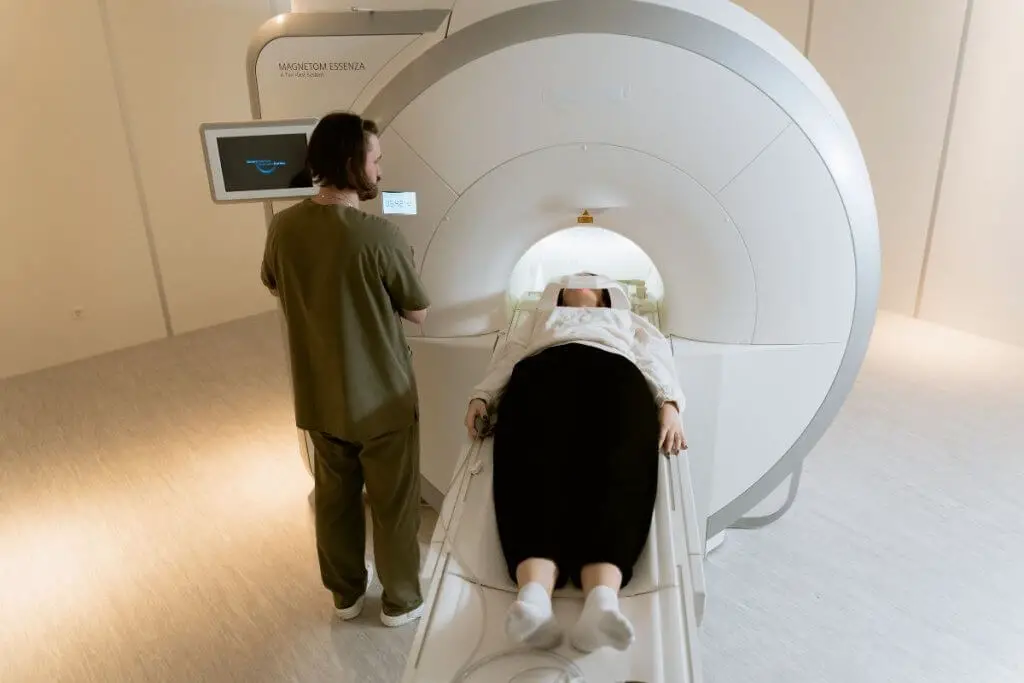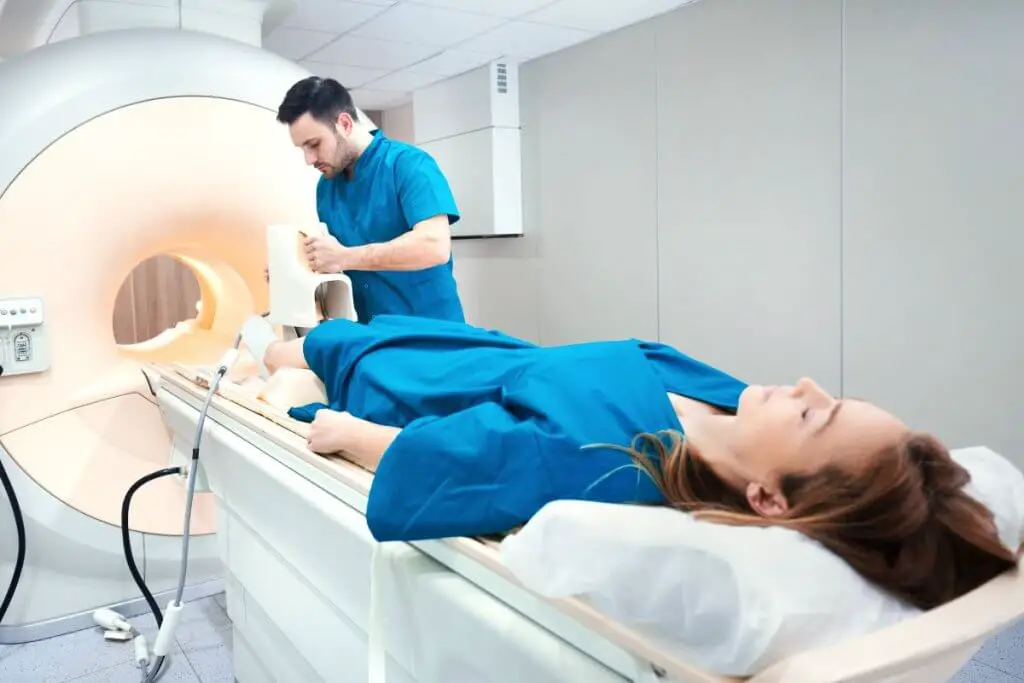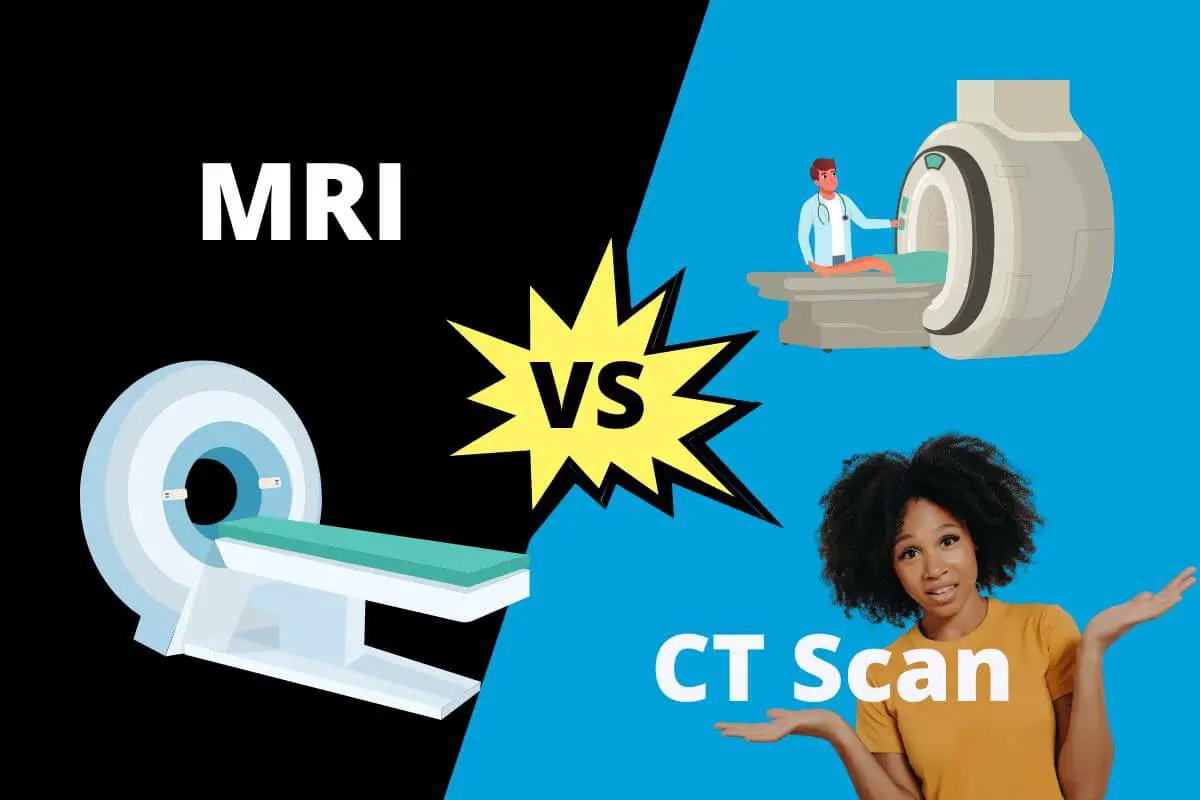Magnetic Resonance Imaging (MRI) uses strong magnets and radio waves to get images of our internal organs, bones, and tissues. Computed Tomography or CT scan uses x-rays to create multiple cross sections of our bodies.
CT scan and MRI are both used for imaging and detecting different medical conditions. Because both processes take images of our internal body parts, people think they are the same. But they are not.
Some medical conditions require MRI, and some require a CT scan; if you want to know which one would be best for your ailment, continue reading this article.
Table of Contents
MRI vs CT Scan – Key Differences
| MRI | vs | CT Scan |
| The first commercial MRI scan was available from 1981 | History | Sir Godfrey Housenfield invented the first commercially usable CT scan machine. On 1st October 1971, doctors performed the first brain scan. |
| The machine detects tissues containing hydrogen atoms (water) are made to emit radio signals which are detected by the MRI scanner | How the machine works | Multiple radiations are sent to the moving body then the computer processes a series of x-ray data. |
| Magnetic resonance imaging | Full form | Computerized axial tomography |
| MRI machine does not emit radiation | Exposure to radiation | Emits 2 to 10 MSV of ionizing radiation. Even though it’s not harmful, pregnant women and children are not recommended for CT scans. |
| Requires at least an hour | Duration | Does not take more than 10 minutes |
| None | Side effects | Exposes our bodies to radiation |
| Soft tissue evaluation like tendon and ligament injury, brain tumors, spinal cord injury, etc. | Effective on | Effective in detecting bone injury, cancer, chest, and lung scan |
| Ranges from $1,200 to $4000 | Cost | Ranges from $1,200 to $3000 |
| Very accurate and gives clear images of our internal organs | Accuracy | CT images are also very accurate but less effective on soft tissues |
What is MRI?
MRI uses powerful magnetic fields and radio waves to get detailed images of our bodies.
Because MRI gives more in-depth images of our bodies, doctors recommend it for more serious medical conditions.
MRIs Can Detect
- Tumors
- Cancers
- Blood vessel irregularities
- Joint abnormalities
- Inflammatory bowel conditions
- Brain problems
- Bone and liver disorders
How Does MRI Work?
Our bodies are mostly water (H2O), which contains hydrogen nuclei. Hydrogen nuclei (protons) constantly move in our body’s magnetic fields. When MRI emits the radio waves to our bodies, they align with the protons.
The scanner also emits a radio frequency current that creates a different magnetic field, causing protons to flip their spin. And when the radio frequency is turned off, the protons resume their normal spin.
This process is called a procession, during which radio signals are produced. The machine can measure these radio signals and compute them into an image.
Getting an MRI
Before the MRI, you may need a contrast agent. A contrast dye is injected, or you’ll have to drink the solution, depending on which part of your body is getting scanned. Then you’ll have to change into a hospital gown or medical scrub.
After that, you’ll have to lie on the scanner table and slide inside the MRI machine. Some specific scans require you to hold your breath because the breathing movements may affect the results.

What is a CT Scan?
Computerized Axial Tomography (CAT) or CT scan uses different x-rays from different angles to get a detailed image of a particular part of the body. Doctors use CT scans to detect problems with our bones, soft tissues, brains, and multiple other organs.
CT Scans Can Detect
- Abdominal abnormalities
- Circulation problems
- Lung issues
- Urinary bleeding problems
- Skeletal system problems
- Bone fractures, etc.
How Does a CT Scan Work?
The CT scanner sends multiple radiation beams to the moving body when it slides through the machine. When the scan is complete, a computer processes the x-ray data. It creates either two-dimensional or three-dimensional x-ray images.
Getting a CT Scan
Before the CT scan, your doctor might ask you to drink a contrast or will inject it. After changing into medical gowns, you’ll lie on a table and inside the machine. The process is quite similar to the MRI.
But the CT scanner is much quieter than the MRI machine, and the process gets over within ten minutes. You’ll experience no pain during the process.
What’s the Difference Between MRI and CT Scan?
Radiation
CT scans use small doses of ionizing radiation, but MRI does not use radiation.
Radiation may cause cell damage which may lead to cancer. But medical experts have stated that because the radiation level in CT scans is very low, there is little to zero chance of developing cancer.
Time
CT scan is a much faster process than MRI.
CT scan takes about ten minutes but may vary slightly depending on the body part. But MRI takes about an hour to complete the whole medical imaging procedure.
Images
MRI gives more detailed and precise pictures compared to CT scans. CT scans, at times, may not be able to produce distinct images of behind the bones or soft tissues.
Sound
MRI machines are noisy, so doctors give you earplugs or headphones to reduce the effect. Compared to that, CAT scan machines produce less noise, and you don’t need headphones.
Accuracy
Even though both procedures produce highly accurate results, MRI is slightly more detailed than CT scans. Sometimes doctors follow an MRI after a CT scan because of the CT’s inability to take clear pictures of soft tissues.
But the accuracy sometimes also varies depending on the technician’s experience and ability to position the patients correctly.
Cost
Because of the precision and clarity of results, MRIs are more expensive than CT scans. A single MRI session would cost you around $2000, and a CT scan costs around $1,200.

MRI vs CT Scan – Know the Difference
CT and MRI are powerful imaging methods that help physicians detect serious medical conditions. While both can produce clear images of the body, which method will be better for whom will depend on individual conditions.
If you’ve enjoyed this article, check out our post on the difference between proximal and distal.

